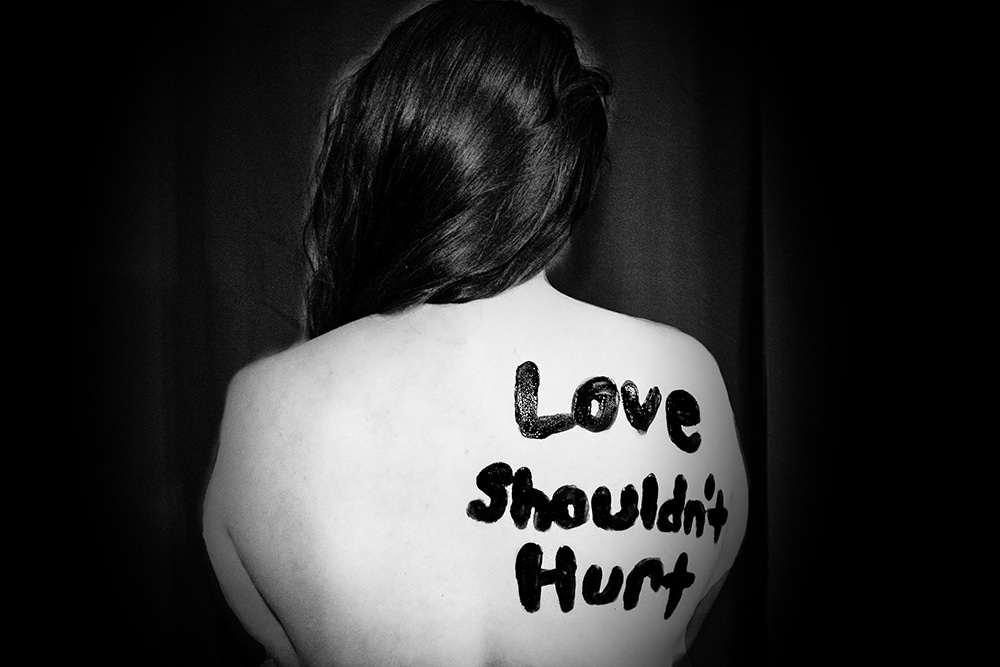*Editor’s Note: The “Views from NAU” blog series highlights the thoughts of different people affiliated with NAU, including faculty members sharing opinions or research in their areas of expertise. The views expressed reflect the authors’ own personal perspectives.
 By Amy Bonomi, associate dean of strategic initiatives and professor of public health in the College of Health and Human Services
By Amy Bonomi, associate dean of strategic initiatives and professor of public health in the College of Health and Human Services
Dr. Bonomi is an international expert in domestic abuse and researches the dynamics of recanting victim testimony and sexual abuse in romantic relationships of college students. Her latest book, Recantation and Domestic Violence: the Untold Story, will be published this fall.
Content warning: This essay contains vivid descriptions of abuse. Reader discretion is advised.
Ever-Lasting-Love: John and Maria
Maria and John dated from their sophomore year of high school until their second year in college. Their first date was “like fireworks,” and they each felt they had found the love of their life.
Maria and John did everything together: went to the movies, drove up to Snowbowl to watch the sun set, even got matching tattoos—a heart with an inscription that resembled “fireworks:”
To others, everything about Maria and John’s relationship looked great. Early on, Maria’s friends teased that she would be the first of their group to “get hitched.”
However, despite outward appearances, John was angry and jealous. When Maria went out with friends, John would insist that Maria send pictures of herself and her friends to “prove” she wasn’t with another guy. Often, John reinforced his request with proclamations of his love for Maria and that he “wanted to make sure she was not being harassed by some other guy.”
When Maria needed to study, John would complain that his back hurt and insist that Maria massage it.
If Maria was sleeping, John would wake Maria and insist that they have sex like “husband and wife.” Maria and John were not married. Yet, John would often refer to their roles as “husband and wife” and promised to “put a ring on Maria’s finger.” Yet, John also “teased” Maria that he wouldn’t marry her until “she stopped being fat and ugly.”
At first, Maria was flattered by John’s requests for pictures, by his proclamations of love, when he woke her to have sex. Maria loved John; she hoped that John would propose, and they would eventually have children and a family together.
Yet, John’s anger and jealousy became worse. It became so bad that Maria started to keep an electronic file of John’s text messages and behaviors.
One evening, neighbors called police when they heard John screaming at Maria and throwing furniture. John had strangled Maria until she “saw stars.”
John was booked into jail and started to call Maria from jail. Some of their calls sounded like nothing had happened; John and Maria discussed how their days went and how much they missed each other. However, during other calls, John blamed Maria for the abuse and instructed her to call the judge to say “nothing happened.” When Maria attempted to set a boundary with John (“you can’t do this to me anymore; you’re an abuser”), John would feign that he was having an anxiety attack and wanted to take his own life.
When John threatened to take his own life, Maria felt sorry for him and agreed to help him get out of jail.
After many calls from John, Maria called the domestic violence advocate to say nothing happened.
Maria’s story is one that is unfortunately common. The World Health Organization (2021) estimates that 27 percent of women aged 15–49 have been subjected to physical and/or sexual violence by their partner. Women aged 15-24 are at highest risk. For cases that reach the criminal justice system, upwards of 80 percent of victims “recant,” or take back, the story they told police, the judge, the domestic violence advocate. “Recantation” is often manipulated by the abuser telling the victim that the abuse wasn’t as severe as it was; holding out promise of marriage, of change, of rehabilitation; and by manipulating the victim into feeling sorry for him.
Relationships such as Maria and John’s are the focus of my forthcoming book with David Martin, Recantation and Domestic Violence: The Untold Story. We cover an in-depth analysis of jail calls (first published in 2011) between abusers and their victims to influence victims to recant.
Our book also discusses strategies for improving community response to domestic violence, along with the telltale signs of abuse, such as the signs in Maria and John’s relationship:
- Jealousy (John insisting that Maria send photos of herself under the guise of “I love you” and “I care about you”)
- Controlling behaviors (John interrupting Maria’s need to study and sleep and instead directing her attention towards him)
- Manipulation (John feigning an anxiety attack and threatening to take his own life)
- Emotional abuse (John telling Maria he wouldn’t marry her “until she lost weight and stopped being ugly”)
- Pressured sex (John waking Maria to have sex under the guise of “I love you” and “I want to have a family with you”)
Maria and John continued in their relationship for nine months after John spent time in jail, until John’s abuse was too much. After working with a domestic violence advocate to develop a safety and exit plan, Maria left John to live with a friend in another state. Today, Maria is living a violence-free life and thriving.
If you and/or someone you know is experiencing abuse, the following free resources are available:
- National Domestic Violence Hotline: Domestic Violence Support | National Domestic Violence Hotline (thehotline.org): includes 24-7 phone, text, and chat support. 1-800-799-SAFE or text START TO 88788.
- National Sexual Assault Hotline: RAINN | The nation’s largest anti-sexual violence organization. 1-800-656-HOPE.
- Arizona Sexual and Domestic Violence Helpline | ACESDV. 602-279-2980 | (800) 782-6400 | SMS Text Line: (520) 720-3383.
Top photo: Sydney Sims on Unsplash




 By
By